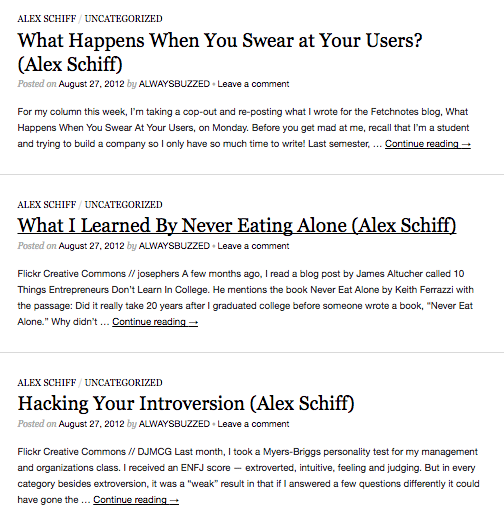Growth I: Finding Your First 1,000 Users
Episode #4 of the course The crash course guide to starting up by Alex Schiff
Hi all,
Today, we’re going to talk about how to find your earliest customers before you have a marketing budget or perhaps even a real product. Specifically, we’ll review tactics to reach your first ~1,000 users (or ~100 paying customers).
Don’t Ignore Your Existing Networks!
No matter what your product is, your first 100 users for a free product or your first five to ten customers for a paid one will almost inevitably come from your personal network and their connections:
• friends
• family
• classmates (past and present)
• co-workers (past and present)
• acquaintances relevant to what you’re building
First-time entrepreneurs can sometimes be reticent to leverage their own networks, but they’re missing out on the most frictionless source of help: people who already know you. Post a call on Facebook or Twitter for people interested in what your product does, and don’t be afraid to message people directly. If you’re building an enterprise product, find the five to ten people you know closest to that world and ask them if they know anyone. An easy hack is looking on LinkedIn for people with your target job title or in your target industry, and then filter by the first and second degree.
Content Creation, Community Building, and Early PR
Coming from a journalism background, it was natural to start blogging about anything I could—my journey into entrepreneurship, early thoughts on what the productivity/collaboration market needed, the trials of being a student entrepreneur, and even a Republican Primary Debate Watch drinking game (and I thought 2010 was a tough year…).

Traction came slowly. At first, only my friends would read and share my posts, but eventually, I noticed their acquaintances and acquaintances of acquaintances started getting on our beta list. Then, a member of my local startup community reached out and asked if we could grab coffee and get to know each other. Over time, bigger media outlets and organizations started republishing what I was writing (including Startup America), and I was able to leverage that credibility to guest post on other people’s blogs or gain media coverage from other local news outlets.
This also isn’t just about starting a blog. It includes:
• tweeting articles relevant to your industry, following people doing the same, and engaging them in conversation
• building an Instagram community around visual content related to your industry
• responding to questions on Quora or Reddit about your industry or expertise
• joining (or creating!) Facebook, LinkedIn, or Slack groups related to your field
• creating a podcast where you interview the movers and shakers in your market
• (Serious note: This is the best business development hack I’ve ever done.)
• becoming a regular contributor or columnist for industry magazines or websites
Events
Every industry has meetups, happy hours, and other informal events. Check out Scour Meetup, Eventbrite, and other websites to find the events relevant to your user base, and bring a stack of business cards. But leave your shyness at the door!
Cold Emails
Ah, the dreaded cold email (i.e. reaching out to people with whom you have no prior contact or relationship)—the bane of existence for, well, most people.
As uncomfortable as it may be, becoming skilled at writing cold emails will probably be one of the best ROIs on your time as an entrepreneur (and most people start terrible at it). You can get surprisingly far with a short, well-written email or LinkedIn message to the effect of: “Hey, I’m building this thing for people like you, and I’d love to get your feedback if you have 15 minutes to chat.” Cold emails are a numbers game, and you should expect to be ignored most of the time. But if it takes you 10 minutes per email, you get a 20% response rate, and you spend an hour per day on this, that’s eight-plus new customer contacts per week—not to mention free messaging testing!
The point is: You don’t need massive numbers to collect meaningful feedback that helps you iterate toward product-market-fit.
Tomorrow, we’ll cover how to take this to the next level once you’re there!
Onward!
Alex
Recommended book
Contagious: Why Things Catch On by Jonah Berger
Share with friends

